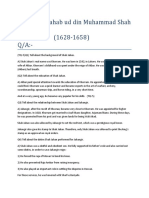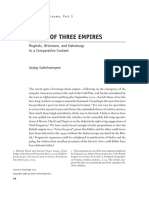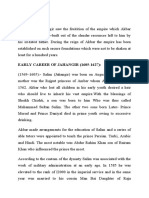Aurangzeb
Aurangzeb
Uploaded by
Nurul AzlinCopyright:
Available Formats
Aurangzeb
Aurangzeb
Uploaded by
Nurul AzlinCopyright
Available Formats
Share this document
Did you find this document useful?
Is this content inappropriate?
Copyright:
Available Formats
Aurangzeb
Aurangzeb
Uploaded by
Nurul AzlinCopyright:
Available Formats
CORRESPONDENCE
191
Aurangzeb's Policies and the Decline of the Mughal Empire
In the February 1976 issue, Professor M. N. Pearson attempted an analysis of the determinants in the decline of the Mughal Empire.1 He attributes the empire's crisis to two principal factors: (1) the poor and unsatisfactory performance of almost all the powerful Mughal nobles; (2) Aurangzeb's move south in 1681-82. Though one may join issue with Professor Pearson in several matters, I shall limit myself here to the two most crucial points noted above. Whereas the decadent character of Aurangzeb's umerab is generally accepted, Pearson does not seem to have taken into account the fact that, of his approximately 14,500 mansabdars in 1695, at least 8,000 existing in 1647 were, together with the crown, received by Aurangzeb as a legacy of the House in 1658. By about the middle of Emperor Akbar's reign (1556-1605), the Mughal mansabdars had succeeded in arrogating to themselves the right of decision-making on vital issues of the empire. In the nineteenth regnal year, Akbar replaced land assignment with cash salaries to imperial officers,2 but such was the pressure from his nobles that, within a few years, he restored status quo ante.3 The imperial mansabdars, already enjoying almost all the military and executive powers in the realm, were henceforth in addition enabled to acquire more or less complete rights over the land revenue of the non-khalisa areasa circumstance that over the decades rendered the mansabdar community virtually supreme in the empire. It is well known that Emperors Jahangir (1605-27) and Shah Jahan (1627-58), leaning heavily on the mansabdars, had elevated and expanded their ranks. Aurangzeb's maintaining and further expanding the community was merely to honor the dynasty's commitment to them. Pearson would perhaps have done better if he had criticized Aurangzeb for so stubbornly and unimaginatively hanging on to the tradition, since the approximately 7,000 new mansabdars he enlisted over the last five decades were no improvement upon the older set of umerah. Pearson puts Aurangzeb in the dock once again when he contends that what sounded the death knell of the Great Mughals was the emergence of Shivaji and his Marhattas as a parallel powerful body. Worse still, while Aurangzeb generally blundered in his dealings with the Marhattas, on four specific occasionsaccording to Pearson's assessmenthis unwise and tactless handling of the rebels was decisive: in 1657, when, dissubedar of the Deccan, he failed to avail himself of the opportunity of crushing Shivaji, who had not yet grown too powerful; in 1659, when Shaista Khan's debacle occurred; in 1664, when Shivaji sacked Surat with impunity; and finally in 1666, when the arch-rebel was presented to the Emperor at Agra. Shivaji and his band of followers were undoubtedly a formidable force in the later half of the seventeenth century, and the fact remains that Aurangzeb and his nobles failed to suppress them. It may also be conceded that Marhattasby their perseverance, audacity, and vigorhad largely contributed to the general weakening of the empire and to the erosion of imperial prestige, time, and energy. But Marhattas as a body did
"Shivaji and the Decline of the Mughal Empire,"JAS, XXXV, pp. 221-35. 2 Abul Fazl, Akbarnama (Persian ed.), Ill (Calcutta, 1886), p. 117.
1
Fazl, pp. 292, 327; Badayuni, Mitnlakhebat-utTawarikh, II, trans, by Ranking and Lowe (Patna, 1973), pp. 188, 193, 218.
192
JOURNAL OF ASIAN STUDIES
not exist when Akbar died; they arose and grew over the subsequent decades. Their principal asset was their large and ever-growing strength of followers. Aurangzeb, however, did not ascertain the causes of the swelling of the Marhatta ranks, nor did he check the outflow of men from the imperial domains into Marhatta arms. Instead, Aurangzeb embarked upon a twenty-five-year-long campaign to reduce the insurgents. In other words, Aurangzeb omitted to trace the cause of the trouble, and confined himself to dealing with the resultant phenomenon of Shivaji and Marhatta power. Substantially following Aurangzeb, Pearson too concentrates almost exclusively on Aurangzeb vis-a-vis the Marhattas, disregarding the facts of the origin, character, composition, and circumstances attending the rise of Marhatta power. Large migrations of able-bodied men from their settled trade and base are usually prompted by political insecurity, social barriers, or economic crises; and it would seem that Marhattas (as well as the Sikhs, Jats, or Bundelas) were in fact the result of some unfortunate developments in the preceding decades within the imperial dominion occasioning large movements into rebel camps. Even the fact that, as the imperial arms made their halting progress in victories, it only added to the size and strength of the Marhattas, did not make either Aurangzeb or Pearson think twice before committing themselves any further. Each yard of land gained by Aurangzeb drove at least one individual to find refuge and perhaps livelihood with the Marhattas. As a matter of fact, in medieval times, social and economic changes were very slow indeed: the rebel forces that crystallized during Aurangzeb's reign could not (and actually did not) emerge at one stroke in 1658. The origin and beginnings of the Marhattas, Sikhs, Jats, and Bundelas can, with the help of available sources, be traced back to Jahangir or early years of Shah Jahan's reign; Aurangzeb merely reaped what his father and grandfather had sown. He certainly stumbled and blundered when faced with the predicament, but it is less than fair to hold him responsible for the sins of his royal progenitors. Finally, societies, including that of the Great Mughals, are complex in character. To ascribe the 1707 catastrophe, and all that followed in its train, to a single cause especially in the absence of a whirlwind invasion of a Taimur or a Nadir Shahis an oversimplification. A Marhatta, Sikh, or Jat rebellion may weaken an empire or even reduce its territory, but in order to see the qualitative changes that came over the shape and interests of the empire, the threads of a denouement as complex as that of 1707 have to be sought very much earlier.
HAMIDA KHATOON NAQVI
Jamia Millia Islamia, Delhi
You might also like
- Lisa Balabanlilar - The Emperor Jahangir Power and Kingship in Mughal India-I.B. Tauris 2020100% (1)Lisa Balabanlilar - The Emperor Jahangir Power and Kingship in Mughal India-I.B. Tauris 2020248 pages
- Atty. Cecilio D. Duka, Ed.D.: Lecturer Mandatory Continuing Legal Education (MCLE)100% (1)Atty. Cecilio D. Duka, Ed.D.: Lecturer Mandatory Continuing Legal Education (MCLE)1 page
- aurangzebs-policies-and-the-decline-of-the-mughal-empireNo ratings yetaurangzebs-policies-and-the-decline-of-the-mughal-empire2 pages
- Emperor Aurangzeb and fall of Mughal Empire (1)No ratings yetEmperor Aurangzeb and fall of Mughal Empire (1)14 pages
- JAHANGIR (Ruled 1605-1629) Emperor Jahangir (1569-1627, Ruled 1605-1629), Akbar's Son, Is KnownNo ratings yetJAHANGIR (Ruled 1605-1629) Emperor Jahangir (1569-1627, Ruled 1605-1629), Akbar's Son, Is Known2 pages
- Circumstances Leading To The Annexation of The Punjab (1846-1849) - Jagmohan Mahajan100% (1)Circumstances Leading To The Annexation of The Punjab (1846-1849) - Jagmohan Mahajan134 pages
- Factors for the decline of the Mughal EmpireNo ratings yetFactors for the decline of the Mughal Empire13 pages
- The Coins of The Moghul Emperors of Hindustan in The British Museum / by Stanley Lane-Poole Ed. by Reginald Stuart PooleNo ratings yetThe Coins of The Moghul Emperors of Hindustan in The British Museum / by Stanley Lane-Poole Ed. by Reginald Stuart Poole621 pages
- Crisis and Disintegration of The Nogai HordeNo ratings yetCrisis and Disintegration of The Nogai Horde3 pages
- 1.india During Advent of Europeans PW Modern IndiaNo ratings yet1.india During Advent of Europeans PW Modern India15 pages
- A Critique of Aligarh Group of Theses Has Been Developed by A Number of Historians From Outside AligarhNo ratings yetA Critique of Aligarh Group of Theses Has Been Developed by A Number of Historians From Outside Aligarh23 pages
- Slave Soldiers and State Politics in Early 'Alawi Morocco, 1668 - 1727No ratings yetSlave Soldiers and State Politics in Early 'Alawi Morocco, 1668 - 172710 pages
- Haseeb Javed Ciit BCS 128 (6B) Pakistan Studies: Topic: Mughal Empires and Downfall of Muslim SociteyNo ratings yetHaseeb Javed Ciit BCS 128 (6B) Pakistan Studies: Topic: Mughal Empires and Downfall of Muslim Socitey20 pages
- SUBRAHMANYAM, Sanjay. A Tale of Three Empires Mughals, Ottomans, and Habsburgs in A Comparative Context. Common Knowledge 12-1-66-92 2006No ratings yetSUBRAHMANYAM, Sanjay. A Tale of Three Empires Mughals, Ottomans, and Habsburgs in A Comparative Context. Common Knowledge 12-1-66-92 200627 pages
- Causes Behind The Downfall of The MughalNo ratings yetCauses Behind The Downfall of The Mughal21 pages
- Aurangzeb Emperor of Mughal India 195488No ratings yetAurangzeb Emperor of Mughal India 1954884 pages
- Mughal Assignment It Talks About Jahangirnama 4No ratings yetMughal Assignment It Talks About Jahangirnama 46 pages
- Mughal Assignment It Talks About Jahangirnama 40% (1)Mughal Assignment It Talks About Jahangirnama 46 pages
- Cultural Achievements of Shah Jahan's ReignsNo ratings yetCultural Achievements of Shah Jahan's Reigns6 pages
- Lewis Ch2 Silver, Inflation and EconomyNo ratings yetLewis Ch2 Silver, Inflation and Economy19 pages
- Causes of the decline of the Mughal EmpireNo ratings yetCauses of the decline of the Mughal Empire4 pages
- 2015.61973.maasir I Alamgiri 1947 - TextNo ratings yet2015.61973.maasir I Alamgiri 1947 - Text367 pages
- Attendant Lords: Bairam Khan and Abdur Rahim, Courtiers and Poets in Mughal IndiaFrom EverandAttendant Lords: Bairam Khan and Abdur Rahim, Courtiers and Poets in Mughal IndiaNo ratings yet
- Decline and Disintegration of The Mughal EmpireNo ratings yetDecline and Disintegration of The Mughal Empire24 pages
- Handout 1 - Emperor Aurangzaib & Decline of MughalsNo ratings yetHandout 1 - Emperor Aurangzaib & Decline of Mughals5 pages
- From Spring to War: Ancient Chinese History, 1046 BC - 475 BCFrom EverandFrom Spring to War: Ancient Chinese History, 1046 BC - 475 BCNo ratings yet
- Rajadhirat's Mask of Command (c.1348-1421)No ratings yetRajadhirat's Mask of Command (c.1348-1421)27 pages
- 3 2 - Racine County Community Resource List - Kacey RexhausenNo ratings yet3 2 - Racine County Community Resource List - Kacey Rexhausen16 pages
- Namma Kalvi 11th Accountancy Question Bank and Worksheet em 216265No ratings yetNamma Kalvi 11th Accountancy Question Bank and Worksheet em 216265112 pages
- Crescent Petroleum, Ltd. vs. MV Lok MaheshwariNo ratings yetCrescent Petroleum, Ltd. vs. MV Lok Maheshwari24 pages
- Marginalizing The Bard - Playwrights of Color & ShakespeareNo ratings yetMarginalizing The Bard - Playwrights of Color & Shakespeare17 pages
- Answer To Questions For ALBA - EIN# 20-8804935No ratings yetAnswer To Questions For ALBA - EIN# 20-88049354 pages
- The Electric Car Revolution Article by JForrest EnglishNo ratings yetThe Electric Car Revolution Article by JForrest English6 pages
- Jaime Gosiaco vs. Leticia Ching and Edwin Casta GR No. 173807 April 16, 2009No ratings yetJaime Gosiaco vs. Leticia Ching and Edwin Casta GR No. 173807 April 16, 20094 pages
- Karnataka Municipal Corporation Model BylawNo ratings yetKarnataka Municipal Corporation Model Bylaw8 pages
- Job Description - Client Services Representative (PG)-1No ratings yetJob Description - Client Services Representative (PG)-12 pages
- Does Process Theology Rest On A MistakeNo ratings yetDoes Process Theology Rest On A Mistake11 pages
- Custodial Mothers and Fathers and Their Child Support: 2015: Current Population ReportsNo ratings yetCustodial Mothers and Fathers and Their Child Support: 2015: Current Population Reports17 pages

























































































